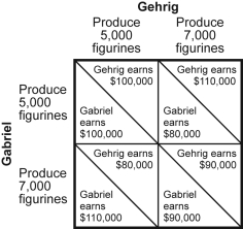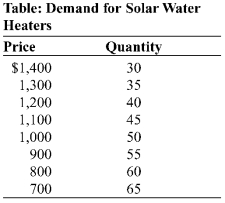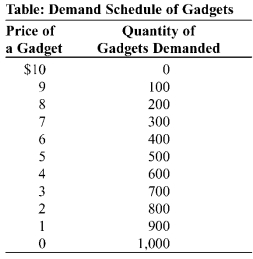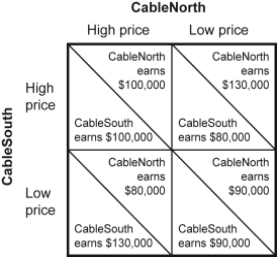Correct Answer

verified
Correct Answer
verified
Multiple Choice
Maximization of joint profits is most likely when firms are:
A) perfect competitors.
B) monopolistic competitors.
C) duopolists who collude.
D) natural monopolists.
Correct Answer

verified
Correct Answer
verified
Multiple Choice
Use the following to answer questions:
Figure: Payoff Matrix for Gehrig and Gabriel  -(Figure: Payoff Matrix for Gehrig and Gabriel) The figure Payoff Matrix for Gehrig and Gabriel describes two people who sell handmade Davy Crockett figurines in San Antonio. Both Gehrig and Gabriel have two strategies available to them: to produce 5,000 figurines each month or to produce 7,000 figurines each month. If both follow a tit-for-tat strategy, equilibrium will be reached when Gehrig produces _____ figurines and Gabriel produces _____ figurines.
-(Figure: Payoff Matrix for Gehrig and Gabriel) The figure Payoff Matrix for Gehrig and Gabriel describes two people who sell handmade Davy Crockett figurines in San Antonio. Both Gehrig and Gabriel have two strategies available to them: to produce 5,000 figurines each month or to produce 7,000 figurines each month. If both follow a tit-for-tat strategy, equilibrium will be reached when Gehrig produces _____ figurines and Gabriel produces _____ figurines.
A) 5,000; 5,000
B) 7,000; 7,000
C) 7,000; 5,000
D) 5,000; 7,000
Correct Answer

verified
Correct Answer
verified
Multiple Choice
Which of the following scenarios best describes an oligopolistic industry?
A) A single cable company serves customers in a small town.
B) Thousands of soybean farmers sell their output in a global commodities market.
C) Coca-Cola and Pepsi sell most of the soft drinks consumed around the world.
D) A college has one bookstore selling textbooks to students.
Correct Answer

verified
Correct Answer
verified
Multiple Choice
Use the following to answer questions:  -(Table: Demand for Solar Water Heaters) Look at the table Demand for Solar Water Heaters. The marginal cost of producing solar water heaters is zero, and only two firms, Rheem and Calefi, produce them. Suppose they agree to produce only 25 water heaters each. If Rheem cheats on the agreement and produces 30 water heaters, what is the price effect for Rheem?
-(Table: Demand for Solar Water Heaters) Look at the table Demand for Solar Water Heaters. The marginal cost of producing solar water heaters is zero, and only two firms, Rheem and Calefi, produce them. Suppose they agree to produce only 25 water heaters each. If Rheem cheats on the agreement and produces 30 water heaters, what is the price effect for Rheem?
A) -$1,000
B) -$2,500
C) $2,000
D) $1,000
Correct Answer

verified
Correct Answer
verified
Multiple Choice
One of the earliest actions of antitrust policy was the breakup of:
A) the Standard Oil Company.
B) Bell Telephone.
C) Microsoft.
D) IBM.
Correct Answer

verified
Correct Answer
verified
True/False
Oligopolistic firms often choose not to compete on price.
Correct Answer

verified
Correct Answer
verified
Multiple Choice
Use the following to answer questions:  -(Table: Demand Schedule for Gadgets) Look at the table Demand Schedule for Gadgets. The market for gadgets consists of two producers, Margaret and Ray. Each firm can produce gadgets with no marginal cost or fixed cost. Suppose that these two producers have formed a cartel, agreed to split production of output evenly and are maximizing total industry profits. If Margaret decides to cheat on the agreement and sell 100 more gadgets, the market price of gadgets will be:
-(Table: Demand Schedule for Gadgets) Look at the table Demand Schedule for Gadgets. The market for gadgets consists of two producers, Margaret and Ray. Each firm can produce gadgets with no marginal cost or fixed cost. Suppose that these two producers have formed a cartel, agreed to split production of output evenly and are maximizing total industry profits. If Margaret decides to cheat on the agreement and sell 100 more gadgets, the market price of gadgets will be:
A) $4.
B) $5.
C) $6.
D) $7.
Correct Answer

verified
Correct Answer
verified
Multiple Choice
The government agency in the United States that reviews proposed mergers of firms in the same industry and prohibits mergers that it believes will reduce competition is the:
A) Commerce Department.
B) Federal Reserve.
C) Labor Department
D) Department of Justice.
Correct Answer

verified
Correct Answer
verified
Multiple Choice
Use the following to answer questions:
Figure: Payoff Matrix for Gehrig and Gabriel  -(Figure: Payoff Matrix for Gehrig and Gabriel) The figure Payoff Matrix for Gehrig and Gabriel describes two people who sell handmade Davy Crockett figurines in San Antonio. Both Gehrig and Gabriel have two strategies available to them: to produce 5,000 figurines each month or to produce 7,000 figurines each month. The combined profits of the two are maximized if Gehrig produces _____ figurines and Gabriel produces _____ figurines.
-(Figure: Payoff Matrix for Gehrig and Gabriel) The figure Payoff Matrix for Gehrig and Gabriel describes two people who sell handmade Davy Crockett figurines in San Antonio. Both Gehrig and Gabriel have two strategies available to them: to produce 5,000 figurines each month or to produce 7,000 figurines each month. The combined profits of the two are maximized if Gehrig produces _____ figurines and Gabriel produces _____ figurines.
A) 5,000; 5,000
B) 7,000; 7,000
C) 7,000; 5,000
D) 5,000; 7,000
Correct Answer

verified
Correct Answer
verified
Multiple Choice
Use the following to answer questions:
Figure: Pricing Strategy in Cable TV Market II  -(Figure: Pricing Strategy in Cable TV Market II) Look at the figure Pricing Strategy in Cable TV Market II. Suppose that after one month, the cable providers follow a tit-for-tat strategy. Eventually they will achieve a tacit collusive equilibrium at which:
-(Figure: Pricing Strategy in Cable TV Market II) Look at the figure Pricing Strategy in Cable TV Market II. Suppose that after one month, the cable providers follow a tit-for-tat strategy. Eventually they will achieve a tacit collusive equilibrium at which:
A) both firms set a low price and each earns $90,000 per month.
B) both firms set a high price and each earns $100,000 per month.
C) CableNorth sets a high price and earns $80,000 per month and CableSouth sets a low price and earns $130,000 per month.
D) CableNorth sets a low price and earns $130,000 per month and CableSouth sets a high price and earns $80,000 per month.
Correct Answer

verified
Correct Answer
verified
Multiple Choice
A trust:
A) is a government agency that regulates natural monopolies.
B) is the new organization that is formed when two firms merge.
C) occurs when shareholders of the major companies in an industry turn over their shares to a board of trustees who then control all of the companies.
D) is another name for a large insurance company.
Correct Answer

verified
Correct Answer
verified
Multiple Choice
As a New York business owner who does a lot of flying, you are keenly aware of even small changes in airfare from New York to Chicago. You have flown this route long enough to know that each airline is essentially a perfect substitute for the others. You notice that every time the largest airline changes the price, smaller airlines follow, but the smaller airlines are always priced slightly below the fare of the largest airline. This industry could best be described as one with:
A) price wars.
B) nonprice competition.
C) cartel behavior.
D) price leadership.
Correct Answer

verified
Correct Answer
verified
True/False
The breakup of Standard Oil in 1911 was one of the first applications of antitrust policy in the United States.
Correct Answer

verified
Correct Answer
verified
Multiple Choice
The study of behavior in situations of interdependence is called:
A) cost-benefit analysis.
B) econometric theory.
C) game theory.
D) strategic theory.
Correct Answer

verified
Correct Answer
verified
Multiple Choice
Antitrust policy refers to government:
A) attempts to prevent the acquisition of monopoly power.
B) attempts to encourage the exercise of monopoly power.
C) encouragement of collusion in the marketplace.
D) attempts to limit private enterprise.
Correct Answer

verified
Correct Answer
verified
True/False
Until recently most other advanced countries did not have policies that prohibited price fixing.
Correct Answer

verified
Correct Answer
verified
Multiple Choice
Use the following to answer questions:
Scenario: Payoff Matrix for Firms X and Y
The following payoff matrix depicts the profits for the only two firms in this oligopolistic industry.  -(Scenario: Payoff Matrix for Firms X and Y) In the scenario Payoff Matrix for Firms X and Y, if firm X were to choose its dominant strategy, it would:
-(Scenario: Payoff Matrix for Firms X and Y) In the scenario Payoff Matrix for Firms X and Y, if firm X were to choose its dominant strategy, it would:
A) choose a low price.
B) choose a high price.
C) encounter a dilemma, since there are two dominant strategies.
D) allow firm Y to dominate the industry.
Correct Answer

verified
Correct Answer
verified
Multiple Choice
Use the following to answer questions:
Figure: Pricing Strategy in Cable TV Market II  -(Figure: Pricing Strategy in Cable TV Market II) Look at the figure Pricing Strategy in Cable TV Market II. The noncooperative equilibrium in the cable TV market occurs when:
-(Figure: Pricing Strategy in Cable TV Market II) Look at the figure Pricing Strategy in Cable TV Market II. The noncooperative equilibrium in the cable TV market occurs when:
A) CableNorth sets a high price and earns $80,000 per month and CableSouth sets a low price and earns $130,000 per month.
B) CableNorth sets a low price and earns $130,000 per month and CableSouth sets a high price and earns $80,000 per month.
C) both firms set a low price and each earns $90,000 per month.
D) both firms set a high price and each earns $100,000 per month.
Correct Answer

verified
Correct Answer
verified
Multiple Choice
Gary's Gas and Frank's Fuel are the only two providers of gasoline in their small town. Gary summarizes his pricing strategy as, "I'll do to Frank what Frank did to me last time." This is an example of:
A) a dominant strategy.
B) a tit-for-tat strategy.
C) an irrational strategy.
D) product differentiation.
Correct Answer

verified
Correct Answer
verified
Showing 221 - 240 of 294
Related Exams